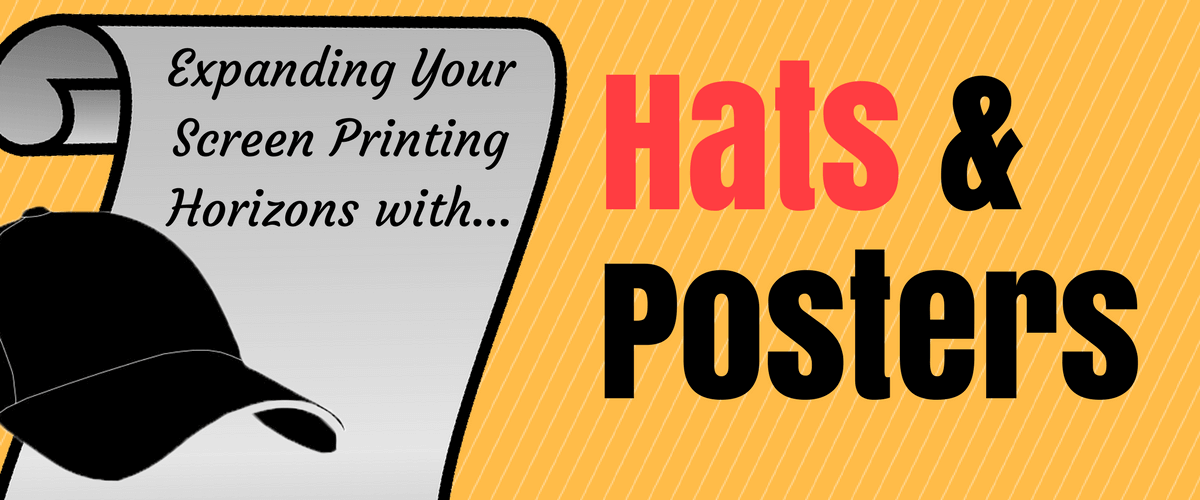No products in the cart.
en

Revolutionizing the screen printing industry through cutting-edge technology and quality service
Phone: +1 847-367-9760
Anatol Equipment Manufacturing Co.
1429 S Shields Dr
Waukegan, IL 60085

Revolutionizing the screen printing industry through cutting-edge technology and quality service
Anatol Equipment Manufacturing Co.
1429 S Shields Dr
Waukegan, IL 60085

Have you considered screen printing on hats? Or getting away from wearables entirely and trying your hand at poster printing? They both may be a departure from what you’re used to, but don’t be afraid to get outside your comfort zone!
Screen printing on hats can be challenging, but with some thought and ingenuity, it can be a worthwhile addition to your printing services. The biggest difference between printing on a hat and printing on a t-shirt is the shape of the printing surface. Screen printing is best suited to printing on flat surfaces, and most hats cannot be flattened easily without damaging them. If you plan on using your existing t-shirt screen printing press for hats, you’ll probably need a special hat pallet to hold their shape during printing. You have to be careful setting up your artwork because it can end up distorted when printed on a curved surface. Practice makes perfect, and with experience you’ll be able to set up your artwork to account for any distortion.

Typical baseball caps are made up of six panels. This creates a seam down the front of the hat which can be problematic for screen printing. Trucker hats are a good alternative because they give you a seamless front panel to print on. Trucker hats are usually more flexible than baseball caps, letting you print flat instead of on a curve without damaging their structure. With any hat, registering a multicolor design can be difficult. A screen printing machine with microregistration will help, but you should try to work with the fewest colors possible.
Why should you try screen printing hats when other methods may be easier? Screen printing can be more cost effective than other printing methods, especially in large quantities. Screen printing is capable of capturing finer detail than embroidery, and it also offers more special effects to work with, letting you create more unique designs. You can use your screen printing machine to print heat transfers of your design, and then apply them to hats with a heat press if you prefer – just be careful not to melt anything! There are even special presses or attachments (even screens) built just for hats, if you plan on making them a large part of your business. A major benefit of screen printing on hats is that most printers are turned off by the perceived difficulty. With a little extra effort, you can make hat printing a profitable niche and turn their loss into your gain!
Screen printing on flat stock like posters is more straightforward than printing on hats, the simple reason being the shape – posters are flat just like t-shirts, so the process is essentially the same. Whether you’re printing concert posters for your favorite local band or museum-quality fine art prints, posters are a great way to show off your creativity, with a handmade feel other printing methods can’t deliver.
While the actual printing itself will be similar to printing t-shirts, there are some extra things to consider when screen printing posters. Choosing the right stock can be overwhelming, so it’s a good idea to shop locally. There’s a lot of variation in paper choices – shopping locally gives you a chance to physically examine your options before you buy, giving you a better idea of how to print your job.
You’ll want to use water-based ink instead of plastisol for printing on paper. Time is of the essence – if you’re not used to working with water-based ink, be careful because it can dry quickly while sitting in the screen, ruining it. Instead of your standard textile ink, you can even use special inks (usually water-based) designed specifically for poster printing. It’s a good idea to use a high mesh count screen to keep the ink deposit thin and produce fine details like halftones.
You’ll have to let the print air dry between colors rather than flash curing it – the heat of a flash cure can warp the shape of the stock and affect your registration. You can use a drying rack or hang the posters on a line, but make sure to keep dust and debris away from your prints. To help with registration on multicolor poster jobs, a set of L-shaped guides marking the top corners of the poster will make it easier to realign your print between colors.

A graphic flatbed press like Anatol’s Color Magic is perfect for poster printing,
letting you print large substrates automatically with a vacuum system built in.
You can use adhesives like you would for a shirt to keep your posters lined up, or you can use a helpful tool called a vacuum pallet. A vacuum pallet is exactly like it sounds; it uses air suction to keep the flat stock held in place on the pallet. No messy adhesive to deal with, just the flick of a switch to keep things properly registered.
Screen printed hats and posters are just the beginning. If you think your product line could do with some expansion, there’s a virtually endless amount of different substrates that can be screen printed. It’s possible your competitors are so preoccupied with shirts that they’ve overlooked the potential of other printed items. If you notice a demand for different products that other shops aren’t offering, you might find a valuable niche you can take advantage of – it’s just a matter of thinking outside the box!
Looking for more ideas on how to create your niche and attract more customers? Keep checking out our blog!
Want to explore the right equipment to meet any printing challenge? Let’s talk screen printing!
Your message was successfully sent!